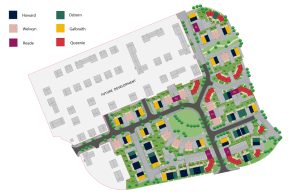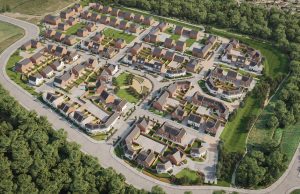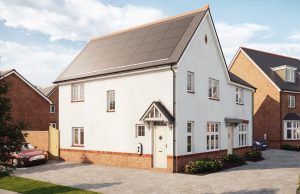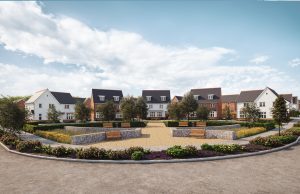PARC EIRIN (PHASES 1 – 3) – INNOVATIVE HOUSING PROGRAMME (YEAR 2)
Background


This project is currently mid-way complete with over 111 homes sold and occupied. The project is supported by over £6Million Welsh Government funding under Year 2 (2018) of the Innovative Housing Programme (IHP) and is a collaboration between Pobl (Housing Association), Trion Homes, Morganstone and Sero.
The objective of Parc Eirin was to build a sales-led housing project at scale, incorporating energy efficient design, renewable energy solutions, battery storage and Sero’s Intelligent Energy System (IES). The ‘innovation’ being that Parc Eirin would become the UK’s largest and first such development – providing an insight into the future when all new homes for sale will be EPC A, ‘non-fossil’ and incorporating renewable energy, energy storage and management technologies.
The programme for the completion of Parc Eirin was split into 6 phases. Phases 1 – 3 (111 homes) were completed by Pobl between 2019 and 2022. Phases 4 – 6 will be developed by Tirion Homes and are about to commence, with construction due to complete in 2027.
Placemaking
Parc Eirin is located away from the built form of Tonyrefail, and the nearby villages of Hendreforgan and Gilfach Goch. This physical and visual separation led the designers to create a place based on the natural setting (within a shallow wooded valley) and inspired by a ‘garden village’ aesthetic. The streets and open spaces follow sound urban design principles.
M&E Strategy
The Homes at Parc Eirin incorporate several home technologies which, on a private development of this scale, were innovative at the time.
Quality targets
Homes as Power Stations (HAPS): The homes are designed around a concept of energy generation, storage, import and export. The PV, battery and energy management system enable residents to take advantage of flexible energy tariffs to reduce their energy bills.

Project learning
Parc Eirin (Phases 1 -3) has proven to be very successful in many ways:
- Demand for the homes was very high, and all homes were sold
- A Sales Office and Show Home were included as part of Phase 1 and this proved very useful in demonstrating the technologies in the home to prospective purchasers
- Residents are enjoying low energy bills compared to similar homes for sale with gas central heating and none of the renewable technologies listed above
MONITORING: 2 types of monitoring report were produced for Parc Eirin:
PERFORMANCE REPORT July 2022 (IHP Parc Eirin Summary of Energy Performance Data July 2022 (002))
- Based on data gathered by the IES over a 12-month period from 47 homes (Phase 1) it was possible to produce a report on the energy use, generation, and export patterns in each home
- This demonstrated that the homes were 45% more energy efficient than the typical new homes in the UK and with PV generating on average 67% of annual energy demand
- The best performing homes generated 127% of their energy needs from the PV and the worst performing house types 37% of their energy needs. This variation could be explained by design and number of panels: the best performing being the flat over garage with 24 panels and the worst performing being the townhouse with 4 panels
- The 4-bedroom detached house type is currently running on a monthly bill of £95 which includes the cost of running an electric vehicle
Learning points on the Performance and Technology:
- The Sero Life App is far too basic and should have been designed to provide information on the Import/Export, billing, battery state of charge, PV generation etc.
- The Sero IES meant that the apps for Mixergy and the Kensa Heat Pump were not offered to residents. This reduced the interaction that some residents would have preferred
- The lack of a wall mounted control panel was also an issue – especially when engineers visit the homes and need to borrow a customer’s phone
- The Underfloor Heating zones should be reduced from 3 to 1 which would simplify things and reduce problems with poorly balanced installations and ‘cold spots’.
SOCIAL INSIGHTS REPORT September 2021 (Parc Eirin Insights Stage 1and2 SV (003))
- A team of Research Scientists from Cardiff University conducted interviews with 8 households
- Each household were asked 7 questions before moving in and the same 7 questions, 3 months post occupation
- Motivations
- House Design and Layout
- Innovation – Heating and Hot Water
- Energy Use and Costs
- Environmental Awareness
- Aspirations
- Community
- Most participants gave positive feedback on the thermal comfort and ease of use of the heating system, albeit several comments were made about getting used to the difference between gas central heating and heat pumps
- The app for controlling the heating and hot water is quite basic and some users reported issues with its unresponsiveness and lack of control
- Most residents were satisfied with the hot water provision, albeit some complained about not having enough hot water for multiple baths
- Residents were satisfied with the lower energy bills being experienced and the positive role being played by the PV and battery
- Some residents were initially not happy with the batteries which had been installed in prominent locations (e.g. hallways). However, most got used to the battery in time. The most enduring feedback about the battery was around the lack of any knowledge about what the battery was doing as this was missing from the Sero Life app. Residents felt like they could reduce their bills even more if they were able to align their electricity use with the battery
- All residents were happy with the support received from Sero Life’s customer team who provided a very user friendly and responsive service whenever contacted about an issue
- The availability of an EV charging point on each house/flat was a positive factor with many residents at Parc Eirin switching over to an Electric Vehicle or planning do this in the future.
Recommendations from Social Insights Report
Provide information to residents about the appliances and technology within their homes that they can refer to. Without this information, residents may make erroneous assumptions
- Explain how residents may need to do things differently in their new home e.g. if they cannot dry washing on their radiators, how should they dry it?
- Lack of engagement with smart control systems does not mean residents are disengaged from their energy use, it may indicate issues with the usability of the technology
- While there are challenges to communal EV leasing schemes, there was some enthusiasm for individual EV leasing. Moving to a low carbon home had provided an impetus for some participants to make other lifestyle changes, so could present an opportune time for considering other low carbon technologies
- Communal spaces were viewed as important for establishing a community but were often seen as a low priority for developers to complete
- Residents should be fully informed about monitoring of their properties, how this data will be utilised, and asked for their consent
Project innovation
- The main ‘Innovation’ objective of Parc Eirin is to build a sales-led housing project at scale, where all homes incorporate non-fossil energy efficient design, renewable energy solutions, battery storage and Sero’s Intelligent Energy System (IES)
- This ‘innovation’ would make Parc Eirin the UK’s largest and first off-gas development – providing an insight into the future when all new homes for sale will be EPC A, ‘non-fossil’ with renewable energy, energy storage and management technologies.
M&E Strategy
The Homes at Parc Eirin incorporate several home technologies which, on a private development of this scale, were innovative at the time:
Heating Measures
- Ground Source Heat Pump
- Each GSHP borehole is linked to 4 homes
- ‘Shoebox’ heat pump in each home
- Underfloor Heating – Ground Floor
- Oversized Radiators – Upper Floors (1st and 2nd), and within flats.
- The heating is split into 2 or 3 UFH zones on the Ground Floor and a single zone of oversized radiators on the upper floors. Each zone can be individually controlled in terms of temperature and scheduling
Other Energy/Technology Measures
- Photovoltaic (PV) panels: The number of panels varies on each house type (4-24 panels)
- Mixergy ‘Smart Cylinder’: A hot water cylinder that features ‘machine learning’ to learn the hot water usage habits of the resident and only heat the quantity of water required at the most advantageous tariff
- Each home has a 5kWh Battery located internally
- Electric Vehicle (EV) Chargers: Located on front or side elevations and in communal car parks
- Intelligent Energy System (IES): Supplied and designed by Sero. This controls all the home energy systems to optimise the generation, storage and usage of energy and reduce bills for the resident
- Sero Life App: This enables the resident to set heating preferences for temperature and timing for each zone individually
Challenges
- Parc Eirin is a sales-led development with over 90% of the homes being sold on the open market
- One of the biggest challenges/risks was how well the homes would sell. Would the EPC A rating and the low carbon design attract or put off customers? OR… would this aspect be secondary compared to location, design and price?
- Pobl had no prior experience with this type of development – selling low carbon, non-fossil homes
- Supporting residents (primarily purchasers) living in a completely new type of home, with no gas supply and featuring several electric systems
POSTSCRIPT
- Sero Life withdrew from Parc Eirin in 2024, having taken the decision to no longer provide billing, controls and customer service on new build projects
- Octopus became the energy provider in March 2024
- The heating, hot water, battery and EV charger systems were reverted to ‘native controls’ in November 2024, meaning that residents were put onto the Mixergy, Sonnen and Resideo apps to control their home energy system
- All homes were fitted with wall mounted control panels and new thermostats
- The Sero IES was disconnected from all systems
- In many ways Sero’s withdrawal from Parc Eirin has delivered what many residents were asking for: control panels and apps that provided greater control and insight into battery and PV status, the heating and hot water system
- It is too early to see if the absence of the Sero system will result in higher or lower energy bills
